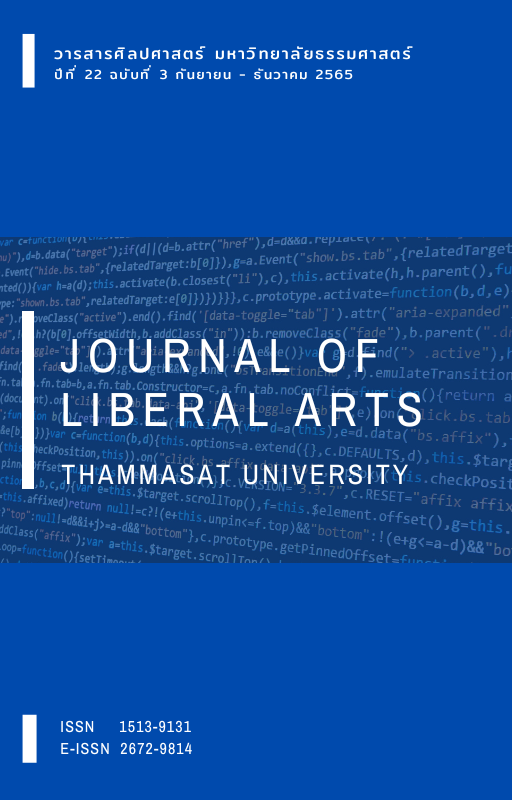แบบแผนการเคลื่อนไหลและปฏิบัติการของผู้ใช้บริการสุขภาพ ข้ามแดนชาวลาวในพื้นที่อาณาบริเวณชายแดนหนองคาย-เวียงจันทน์
Main Article Content
บทคัดย่อ
บทความวิจัยนี้มีวัตถุประสงค์เพื่อศึกษาแบบแผนการเคลื่อนไหลและปฏิบัติการของผู้ใช้บริการสุขภาพข้ามแดนชาวลาวในพื้นที่อาณาบริเวณชายแดนหนองคาย-เวียงจันทน์ การศึกษานี้เป็นการวิจัยเชิงคุณภาพ (Qualitative research) ผู้วิจัยสัมภาษณ์บุคลากรทางการแพทย์ เจ้าหน้าที่ในสถานบริการสุขภาพ คลินิกการแพทย์เอกชน โรงพยาบาลของหน่วยงานรัฐและเอกชน และผู้ใช้บริการสุขภาพชาวลาว ซึ่งเดินทางเข้ามาใช้บริการในพื้นที่จังหวัดหนองคาย อุดรธานีและขอนแก่น ผลการศึกษาพบว่า การเคลื่อนไหลเพื่อการใช้บริการสุขภาพข้ามพรมแดน ถือเป็นการเคลื่อนย้ายในรูปแบบหนึ่งที่เชื่อมโยงกับความสัมพันธ์เชิงอำนาจที่ไม่เท่าเทียม เนื่องจากการเคลื่อนย้ายของผู้คนในการเลือกใช้บริการสุขภาพสะท้อนให้เห็นความสามารถหรือศักยภาพของบุคคลในการเข้าถึงการเคลื่อนย้ายที่แตกต่างหลากหลายและไม่เท่าเทียมกัน ดังจะเห็นได้จากแบบแผนและคุณลักษณะของชาวลาวที่เคลื่อนย้ายข้ามพรมแดนในมิติการท่องเที่ยวและการใช้บริการสุขภาพในโรงพยาบาลรัฐและเอกชนในพื้นที่อาณาบริเวณข้ามแดนหนองคาย-เวียงจันทน์ ส่วนหนึ่งเกิดขึ้นภายใต้เงื่อนไขทางเศรษฐกิจ ความปรารถนา อาชีพ สถานภาพ ความรู้ เครือข่ายทางสังคม รสนิยมการบริโภค ฯลฯ เป็นตัวกำหนดการเคลื่อนย้าย ในขณะที่ชาวลาวบางกลุ่มที่มีฐานะทางเศรษฐกิจและเครือข่ายทางสังคมที่สูงกว่ากลุ่มอื่น ๆ มีโอกาสเดินทางเคลื่อนย้ายข้ามพรมแดนเพื่อการท่องเที่ยวและการใช้บริการสุขภาพข้ามพรมแดนยังโรงพยาบาลของรัฐและเอกชนในจังหวัดอุดรธานีและขอนแก่นมากขึ้น
Downloads
Article Details

อนุญาตภายใต้เงื่อนไข Creative Commons Attribution-NonCommercial-NoDerivatives 4.0 International License.
เอกสารอ้างอิง
กนกวรรณ มะโนรมย์, ปิ่นวดี ศรีสุพรรณ, และ สกุลพรรณ โพธิจักร. (2553). การศึกษานโยบายการพัฒนาเมืองคู่มิตรด้านเศรษฐกิจ: กรณีศึกษาความร่วมมือด้านการเกษตรแบบมีพันธะสัญญายั่งยืนระหว่าง จังหวัดอุบลราชธานี และแขวงจำปาสัก ประเทศลาว พ.ศ. 2551 - 2552. สำนักงานกองทุนสนับสนุนการวิจัย.
กีรติพร จูตะวิริยะ, และ รักชนก ชำนาญมาก. (2560). การไหลเวียนของผู้คนในบริบทของเขตพัฒนาเศรษฐกิจพิเศษหนองคาย: บทสำรวจองค์ความรู้ในมิติการท่องเที่ยวและบริการสุขภาพข้ามแดน. วารสารสังคมวิทยาและมานุษยวิทยา, 36(1), 128-153.
ขวัญชีวัน บัวแดง. (2551). สุขภาพของแรงงานข้ามชาติกับการเข้าถึงบริการสาธารณสุขของรัฐ. วารสารสังคมศาสตร์, 20(1), 145-172.
คชษิณ สุวิชา, อภิชาต ภูแช่มโชติ, และ นรา ยุระชัย. (2557). การจัดสุขภาพแรงงานข้ามชาติบนพื้นที่ชายแดนไทย-ลาว: นโยบายของรัฐและการตอบสนองของภาคประชาสังคมในพื้นที่ จ.หนองคาย. สำนักงานกองทุนสนับสนุนการวิจัย.
จันทนี เจริญศรี. (2561). การเคลื่อนย้ายของแรงงานทักษะสูงในไทย: การเคลื่อนย้าย การเคลื่อนที่และการเคลื่อนย้ายเสมือน. ใน ประเสริฐ แรงกล้า (บรรณาธิการ), ชีวิตทางสังคมในการเคลื่อนย้าย. คณะสังคมวิทยาและมานุษยวิทยา มหาวิทยาลัยธรรมศาสตร์.
ชูพักตร์ สุทธิสา. (2556). รายงานฉบับสมบูรณ์: โครงการกระบวนการเข้าสู่การจ้างงานของแรงงานข้ามชาติลาวในภาคอุตสาหกรรม. สำนักงานกองทุนสนับสนุนการวิจัย.
ประเสริฐ แรงกล้า. (2558). คนกลับพม่า: การเคลื่อนย้ายกลับและทักษะผู้ประกอบการ. วารสารสังคมวิทยามานุษยวิทยา, 34(1), 107-132.
ประเสริฐ แรงกล้า. (2561). ความรู้สึกนึกคิดเชิงเวลาและแรงเสียดทานในการเคลื่อนย้ายกลับพม่า. ใน ประเสริฐ แรงกล้า (บรรณาธิการ), ชีวิตทางสังคมในการเคลื่อนย้าย. คณะสังคมวิทยาและมานุษยวิทยา มหาวิทยาลัยธรรมศาสตร์.
มิ่งสรรพ์ ขาวสอาด, และ จอห์น ดอร์ (บรรณาธิการ). (2550). ความท้าทายทางสังคมในภูมิภาคแม่น้ำโขง. ศูนย์วิจัยสังคมอนุภูมิภาคลุ่มน้ำโขง คณะศิลปศาสตร์ มหาวิทยาลัยอุบลราชธานี.
วัฒนา สุกัณศีล. (2560). การพัฒนาเขตเศรษฐกิจพิเศษชายแดนของประเทศไทย: สถาณการณ์ความเป็นไปได้และข้อจำกัด. วารสารสังคมวิทยาและมานุษยวิทยา, 36(1), 27-55.
วสันต์ ปัญญาแก้ว. (2551). เสรีนิยมใหม่ สังคมไทยยุคหลังรัฐชาติ และการพัฒนาระดับภูมิภาคในเขตลุ่มน้ำโขง. สถาบันวิจัยสังคม จุฬาลงกรณ์มหาวิทยาลัย.
อรทัย ศรีทองธรรม, สุภาภรณ์ สงค์ประชา, วิศิษฎ์ สงวนวงศ์วาน, และ สุวารี เจริญมุขยนันท์. (2556). ผลกระทบจากแรงงานข้ามชาติลาว กัมพูชา และพม่าต่อภาระงานบริการสุขภาพของโรงพยาบาลตามแนวชายแดนในประเทศไทย. สำนักงานกองทุนสนับสนุนการวิจัย.
อาคม เติมพิทยาไพสิฐ. (2557). วิสัยทัศน์และยุทธศาสตร์การพัฒนาประเทศสู่ความยั่งยืน.สำนักงานคณะกรรมการพัฒนาการเศรษฐกิจและสังคมแห่งชาติ.
Brannon, J., James, D., & Lucker, G. (1994). Generating and Sustaining Backward Linkages between Maquiladoras and Local Suppliers in Northern Mexico. World Development, 22(12), 1933-1945.
Cresswell, T. (2006). Mobility in the Modern Western World. Routledge.
Hannam, K., Sheller, M., & Urry, J. (2006). Mobilities, Immobilities and Mooring. Journal Mobilities, 1(1), 1-22.
Kaufmann, V., Bergman, M. M., & Joye, D. (2004). Motility: Mobility as Capital. International Journal of Urban and Regional Research, 28(4), 745-756.
Lin, L., & Jutaviriya, K. (2017). The Transnational Migration Process of New Chinese Migrant Traders in Bobae Market Udontani Thailand. Journal of Mekong Societies, 13(2), 45-64.
Sargent, J., & Mattews, L. (2003). Boom and Bust: Is It the End of Mexico’s Maquiladoras?. Business Horizons, 46(2), 57-64.
Sheller, M., & Urry, J. (2006). The New Mobilities Paradigm. Environment and Planning A: Economy and Space, 38(2), 207-226.
Urry, J. (2000a). Sociology Beyond Societies: Mobilities for the Twenty-First Century. Routledge.
Urry, J. (2000b). Mobile Sociology. The British Journal of Sociology, 61(1), 347-366.
Urry, J. (2005). The complexities of the global. Theory, Culture & Society, 22(5), 235-254.
Urry, J. (2008). Moving on the Mobility Turn. In W. Canzler, K. Kaufmann, & S. Kesselring (Eds.), Tracing Mobilities: Towards a Cosmopolitan Perspective (pp. 13-24). Routledge.


